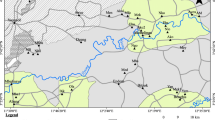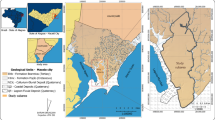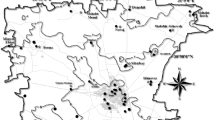Abstract
Searching for borrow pits often used during civil engineering constructions is an important step that requires a lot of time and money. The nature of the parent rock, climate, topography, vegetation and time influence the formation of lateritic gravels with different geotechnical properties within the same region. The present study aims at finding the spatial variability of geotechnical parameters of lateritic gravels from two different deposits using a variogram and statistical analysis. Out of 122 lateritic gravel samples collected, 69 were from underdeveloped lithic ferrallitic soils (LFS) and 53 from under developed non-lithic ferrallitic soils (NLFS). The mean values of the coefficient of variation (CV) shows that the geotechnical parameters of LFS-derived lateritic gravels are more dispersed than those developed on NLFS. The fines content, plasticity index (PI) and Californian bearing ratio (CBR) variograms observed mainly in the North and NNE parts of the study area, suggest that, the lateritic gravels in this area have average to good geotechnical characteristics. The principal component analysis (PCA) indicates that the CBR and the maximum dry density (MDD) are inversely related to the optimum moisture content (OMC). The discriminant factor analysis (DFA) coupled to the ascending hierarchical classification (AHC) shows three families of lateritic gravels: (1) class 1/3, lateritic gravels characterized by MDD, CBR, consistency index (CI), gravels content, and plastic limit (PL); (2) class 2/3, lateritic gravels characterized by fines content, and maximum grain diameter (Dmax) and, (3) class 3/3, lateritic gravels characterized by OMC, liquid limit (LL), PI, PL, and fines content, that fit for road construction.
Article highlights
-
Lateritic gravels developed on lithic ferrallitic soils have the best geotechnical properties, the more they are dispersed than those derived to non-lithic ferrallitic soils.
-
The lateritic gravels with average to good geotechnical properties were observed to the North and NNE parts of the study area.
-
Lateritic gravels of classes 1/3, 2/3 and 3/3 were the three families of lateritic gravels founded in the study area
Similar content being viewed by others
Avoid common mistakes on your manuscript.
1 Introduction
Road infrastructure is a public property that enables and facilitates large-scale transportation and trade. The structures are usually made up of homogeneous materials such as laterite, pozzolan or crushed rock, selected on the basis of the technical specifications of each part of the pavement. Locating the borrow areas for such construction works requires enough time, energy and money. In the intertropical zone, laterites are the most common unconsolidated materials [1, 2] for engineering construction. The term 'laterite' covers complex realities, as lateritic soil formation depends on numerous factors [2,3,4] that vary in time and space. The variation of time can be relatively long, about a million years, and the variation of space can be restricted to a hundred or even a dozen meters [5]. Soil properties do not vary at random in space [6]. Geotechnical properties vary both laterally and vertically (depth). These parameters change gradually following a pattern that can be determined from spatial correlation structures, where soil parameters are treated as random variables [6, 7]. The mean, variance, coefficient of variation and fluctuation range describes the spatial variability of a parameter [6, 8]. In the intertropical zone, the variability of the geotechnical properties of laterites depends on statistical parameters [3, 4, 9,10,11,12]. However, the results of this study were not conclusive due to the uncertainty in the variability of geotechnical analysis [8], and the heterogeneity of lateritic materials [13]. In geotechnical analysis and engineering, the spatial variability contributes to the following: (a) helps to characterize the study area; (b) depends on pedogenetic features related to space position, and (c) shows the heterogeneity of the study area. Uncertainty usually encompasses geotechnical engineering fields, such as the characterization of soil properties. Yet, the spatial variability of soil properties is a function on random uncertainty which is the natural randomness of a property [14]. Random and spatial properties of regionalized variables are determined from geostatistical studies. The variogram serves to quantify the spatial dependence of a property between samples in a specific direction, and the degree of continuity [6, 7, 15,16,Full size table
5.1.2 Variability of Atterberg limits
The coefficient of variation values show that, LL, PL, and PI are more dispersed in LFS-derived lateritic gravels (13, 25, and 8%) than those developed on NLFS (9, 17, and 4%). This variation of the plastic parameters is average in the study area, except for the LL and PI parameters whose variation is lower in the LFS-derived lateritic gravels. The mean LL values (58 and 57%) of LFS and NLFS-derived lateritic gravels are higher than those found in the North-western of Nigeria (12–51%) [42] and the Center Region of Cameroon [3]. However, they are lower than those obtained in East Region of Cameroon (59%), for which the higher rainfall accounts for this difference. The observation of variogram of PI (Fig. 6) shows that the highest values, varying between 28–30%, are mainly observed in the SSE, center, and east parts of the study area. The lowest values (PI = 25–28%) occur mainly in the SSW and in the North. The average PI values (28%) of lateritic gravels developed from LFS and NLFS-derived lateritic gravels indicate plastic materials, such as those usually found in South Region of Cameroon [43,44,45,46]. These average plasticity values are high compared to those found in North West Nigeria (7%) [42], Sapouy (10%) [47], and Ivory Coast (23%) [48], but they are equal to those found in the East Region of Cameroon [49]. The position of mortar of the lateritic gravels studied in the plasticity chart of Casagrande, indicates that those materials are plastic to very plastic (Fig. 7). These materials, close to A-line, show the presence of non-swelling clays, such as kaolinite. This position of mortar of the lateritic gravels studied is different to those obtained on the lateritic gravels in Nigeria, Burkina Faso, and in West and Center regions of Cameroon [42, 50,51,52]. The average value of fines content, coupled with those of plasticity index, shows that these materials are classified B6 according to the GTR classification.
5.1.3 Variability of derived Atterberg Limits parameters
The coefficient of variation of the consistency index (CI) value shows that, this parameter is more dispersed in the LFS-derived lateritic gravels (28.9), than those derived on NLFS (18.8). The CV values show similar dispersion of MBV values in both cases (6.7). These variations of Atterberg limits derived parameters are low (MBV) and medium (CI) in the study area. This conclusion is different to those observed in the laterites derived from metamorphic and sedimentary rocks in the central and southwestern regions of Cameroon [4, 12]. The difference results to the heterogeneity of the laterites [53], and to the Atterberg limits derived parameters of the study area, different from those of the authors mentioned above.
5.1.4 Variability of compaction parameters
The coefficient of variation values show that MDD, OMC and CBR are more dispersed in the LFS-derived lateritic gravels (6.32, 38.24, and 90%) than those developed on NLFS (5.34, 19.56, and 27%). This dispersion of compaction parameters is low (MDD) and medium (OMC and CBR) in the study area. These variations are similar with the previous works. The iso-MDD map (Fig. 8) shows that, the MDD values of lateritic gravels studied, which comprise between 2.00 and 2.10 g/cm3, are mainly observed in the study area. The pockets of the MDD values, range between 1.90 and 2.00 g/cm3, are founded in the SW, center, and NE parts of the study area (Fig. 8). The mean MDD values (2.04 and 2.06 g/cm3) in the LFS and NLFS-derived lateritic gravels, respectively, are lower than those found in Nigeria (2.18 g/cm3), Burkina Faso (2.17 g/cm3), Center region of Cameroon (2.14 g/cm3) [3, 42, 54,]. However, they are similar in laterites derived from chlorito-schists in the Center Region of Cameroon [12]. The OMC variogram Fig. 9) reveals that the values of this parameters, which comprise between 10 and 14%, are mainly observed in the study area. The pockets of the OMC values, varying between 14 and 17%, occur in the center part of the study area. (The average OMC values (12.8–11.9%) of lateritic gravels in the study area are higher than those found in Sapouy laterites (6.6%) [47]. This difference may arise from the clay content [46] in the lateritic gravels of Olama–Ngomedzap compared to those of Burkina Faso. The CV values of CBR show more dispersed values of this parameter in the LFS-derived lateritic gravels (90%) compared to those developed on NLFS (27%). The CBR variogram (Fig. 10) shows that, the CBR values, varying between 19 and 43%, dominate in the study area. The pockets values of this parameter, comprises between 31 and 43%, are observed to the North and NNE of the study area. These average values (26–30%) in lateritic gravels studied are lower from the ranges (31–68%; 60–84%) defined for laterites in southern and central regions of Cameroon [5, 52], Senegal [54] and in the forest zone of Cameroon [3].
5.2 Correlations of geotechnical parameters
The Pearson correlation coefficients (R2) on different datasets are given in Tables 4, 5, and 6. There are weak negative correlations ( − 0.62, − 0.64 and − 0.63) between CBR and OMC, and weak positive correlations (0.59, 0.63 and 0.59) between CBR and MDD. In the study area, CBR values increase simultaneously with those of MDD and decrease with those of OMC. These findings differ from those in Senegal [55], Ivory Coast [56] and the Center and South–West Regions of Cameroon [3, 4, 12]. These authors found no correlation between CBR and other physical parameters. Katte et al. [11] found a similar correlation on lateritic gravels in Southern Cameroon.
5.3 Principal component analysis (PCA)
A Principal Component Analysis was carried out to seek other relations between the parameters. The results applied to all the lateritic gravels in the study area indicate that the first two factorial axes (F1 and F2) express 57% of the total information of the group of individuals and/or variables (Table 7). This percentage is therefore significant and the first plane rightly depicts variability in the entire active dataset. This percentage is lower than in Senegal (71%) [50], Ivory Coast (65%) [51], Morocco (69%) [54], and the Center and South-West Cameroon (79%) [3]; and (61%) [4]. This percentage is, however, lower in laterites derived from micaschists and chlorite-schists (58%) in the Center Region of Cameroon [12]. CBR is far from the correlation circle but close to MDD (Fig. 11). This is consistent with the positive correlation observed between these two parameters. The latter and gravels, CI, PL, LL parameters are opposed to Dmax, sand, fines, MBV, PI, and OMC parameters with respect to axis 1. These variables have an inverse relationship [55]. The correlation matrix (with an R2 = − 0.627) coupled with the OMC and CBR positions in the correlation circle shows an inverse relationship. This observation differs from the one made on laterites from Senegal and South–West Region of Cameroon [4, 50].
5.4 Typology of lateritic gravels
The discriminant factor analysis (DFA) indicates three (3) families of lateritic gravels in the Olama–Ngomedzap area (Fig. 12): classes 1/3, 2/3, and 3/3 lateritic gravels. In class 1/3 with 54 lateritic gravels, the determining parameters for selection for road construction purposes are MDD, CBR, CI, gravels, and PL (Table 8). In class 2/3 with 38 lateritic gravels, gravels, fines, and Dmax (Table 9) are the geotechnical parameters that determine their choice for road construction. In class 3/3 with 38 lateritic gravels, the parameters are OMC, LL, PI, PL, and fines (Table 10). The CBR parameter for the selection of class 1/3 laterites in road construction is common in the intertropical zone [3, 4, 12, 46, 50]. These three families of lateritic gravels in the study area are confirmed by the study of ascending hierarchical classification (AHC) of those materials. The observation of dendogram (Fig. 13) show that, the contributions of each class are 30% (class 1/3), 43% (class 2/3) and 26% (class 3/3) respectively.
5.5 Implication for road construction
The particle size analysis is important to determine the granular classes of the studied materials. This is important to determine their suitability in different pavement layer in road construction [56]. The highest gravels content values in the LFS and NLFS-derived lateritic gravels (58.90 and 59.20%), coupled to the lowest fines content, demonstrates that those materials has ability to resist on water. This ability shows that the lateritic gravels studied have a good behavior in road construction. The mean values of fines content in the LFS and NLFS-derived lateritic gravels (28.10 and 28.40%) lower than 35%, the minimum required for their used in sub-base course [57, 58]. The mean values of the plasticity index in the both materials studied (28% respectively) lower than 30%, the maximum agreed for their used in sub-base course [58]. Their use as sub-base and base course in road construction requires a reduction of this plasticity, through stabilization. The GTR classification (B6) shows that lateritic gravels studied have a good to average performance in road construction. According to the CEBTP [58] and Direction des Etudes Générales et de la Normalisation (DEGN) [59]), lateritic gravels must have a maximum dry density (MDD) values ≥ 1.90 g/cm3 and 2.00 g/cm3 for their use as sub-base and base courses respectively. The mean values of the MDD in the LFS and NLFS-derived lateritic gravels (2.04 and 2.06 g/cm3) are higher than the maximum required to sub-base and base courses for all type of traffic classes. The mean values of the OMC of the lateritic gravels studied (12.80 and 11.90%), range to the interval (8.00–15.00%) recommended of the use of materials in sub-base courses in road construction [58]. The previously authors cited also are recommended that, the lateritic gravels with the 30 and 80% CBR values, can be used as sub-base and base courses for all type of traffic. Due to their mean CBR value (26.40%) inferior to the minimum required as sub-base course, the LFS-derived lateritic gravels must previously stabilized before their used. The mean value of CBR of the NLFS-derived lateritic gravels (30.00%) shows that these materials can be used as sub-base course for T1 and T2 traffic classes.













